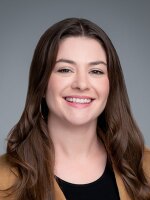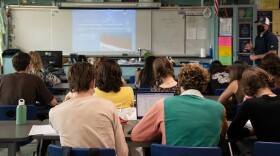This is part one of a three part series. Read part two here.
More high school students report poor mental health, according to CDC data.
School therapist Shea Prophet is trying to find and help these students before they enter high school. He sees himself in many of them.
Prophet said he grew up with a single mother and few resources or role models.
If You Need Help
If you or someone you know is experiencing thoughts of suicide, help is available 24 hours a day. Call or text the Suicide & Crisis Lifeline at 988, or go here for online chat.
For more help:
- Find 5 Action Steps for helping someone who may be suicidal, from the National Suicide Prevention Lifeline.
- Six questions to ask to help assess the severity of someone's suicide risk, from the Columbia Lighthouse Project.
- To prevent a future crisis, here's how to help someone make a safety plan.
His no-nonsense cadence and ramrod straight posture hint at his military background.
After multiple deployments, he became a Navy correctional officer.
He saw himself reflected in the incarcerated men and their challenges. He found himself asking: If they would have had people or resources to support them, would they still be in this situation?
He was paid to enforce the rules, but he began stretching his role — giving the men advice, trying to help with their transition out.
“I used to get feedback from my supervisors,” he said, “‘That’s not what you’re here for. If you want to do this, you need to go back to school and become a counselor.’”
So he did. But during school, he had what he called an epiphany.
If he became a correctional counselor, the men would have to go to a facility to see him, to have already done some sort of crime before he could give them the services they needed.
He pivoted to prevention instead, tracing the school to prison pipeline back to children, like himself, who need resources and aren’t getting them.
Now a program director for SBCS, formerly South Bay Community Services, he oversees an enormous task — screening San Ysidro School District students, second through eighth grade, and providing them with the right behavioral and emotional health services.
To do this, he asks them 21 questions, including: Do you like school? Are you turning in your homework on time? Are you able to get along with others?
Their answers sort them into three tiers.
Prophet’s team places tier two students — those who might need a little extra help — into groups to learn skills like conflict resolution and emotional regulation.
They connect tier three students — who are considered at high risk for things like truancy and mental health issues — with therapists and other resources.
It’s the screening program’s first full school year.
Prophet said it addresses a key problem: Most students who need help don’t seek it.
“Beforehand, all my referrals would come from either the teachers or the parents, but it kind of eliminates the voice of the student themselves,” he said.
Screening lets him bring the services to students, rather than relying on the students to seek them out.
His team also works with caregivers.
“If we're putting a BandAid on it, we're working with them at school, and then they go home and it gets washed off because they don't have the appropriate services or they don't have the resources available to them, then a lot of our work is just going in circles,” he said. “So we try to reach out to the families and see what resources they might need to ensure that the student has the best environment to grow up in.”
Matthew Quitoriano, a high school junior and San Diego Unified student board member, said he sees the current student mental health crisis “not so much as a cause, but rather as a symptom of many other ways we’re neglecting and failing our students.”

“Bell schedule and also the pressure of increasingly low acceptance rates within colleges creates a culture that really is focused on academics and not all the wonderful things that you can learn in high school, like how to make friends,” he said.
Quitoriano said some of the mental health work in the San Diego Unified District is being led by students. In collaboration with UCSD, they’re designing a new mental health curriculum.
“Using the classroom as a space to say, hey, the same way we talk about 'here's what to do if you get scraped on the playground, here's what to do if you hit your head' — the same way that we treat physical injuries, we also want to think about, ‘how do we care for our mental health,’” he said.
Three schools have created wellness centers with state funding, spaces where students can take a short break throughout their day and sit in a calming space.
(Plus, Quitoriano said, they have great snacks.)
But, he said, staffing those wellness centers at all schools is an uphill battle — not against culture, but against limited resources.
“Having an inclusive space is great,” he said, “but without someone in there to look after to make sure that people are really being supported in that space, these wellness centers really can't be reaching their full potential.”
Despite more mental health initiatives in schools, some students fall through the cracks.
A lack of counselors of color, culturally-responsive curriculum and Spanish-language resources can keep Black, Indigenous and Latino students from accessing help.
In the next story in this series, KPBS will look at a group facing some of the highest needs and biggest barriers to asking for help: LGBTQ+ students.





